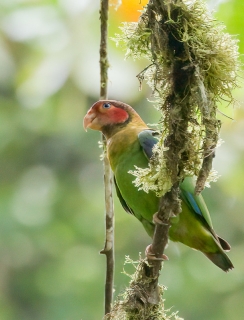Rose-faced Parrot |
|
|
Also known as: Beautiful Parrot
Photos
View in GalleryDid You Know?
Two of the Pyrilia species are bare-headed: the Vulturine Parrot (P. vulturina) and the Orange-headed Parrot (P. aurantiocephala).Academic Research
Related publications: Pyrilia pulchraSpecies Profile
Genus: Pyrilia | Species: pulchra
Size:
23cm (9 in)
Weight:
203-208g (7.1-7.3 oz)
Subspecies including nominate:
one
Colour Adult:
Both adults mainly green in colour; dark grey/brown crown to nape; rose/pink lores to area around eye, ear coverts and hindcheeks; pale rose chin and forecheeks; dull olive/yellow hindneck, reaching to breast where turns to greenish colour; orange and yellow lesser wing coverts and forewing; green axillary feathers and sides of underbody; green tail tipped with blue, with red at base. Bill horn in colour. Eye ring white. Eye yellow.
Colour Juvenile:
Rose/pink on face confined to superciliary line and ear coverts; green/brown cheeks and chin; more green to crown and nape; olive/yellow tinge to green breast. Eye brown.
Call:
Calls made in flight are harsh and shrieking.
Listen NowVideo Links:
Video 1More Information:
Content Sources:
CITES
BirdLife International
Cornell Lab of Ornithology/Birds of the World
Parrots: A Guide to Parrots of the World, Juniper and Parr, 1998
ML Media Collection Catalogue 139042, Rose-faced Parrot Pionopsitta pulchra, Macaulay, Linda, Ecuador, Sep. 22 2003, Cornell Lab of Ornithology. Site
Parrots of the World, Forshaw, 2006. 2010 edition
Lexicon of Parrots, Thomas Arndt.
Photos
View in GalleryDid You Know?
Two of the Pyrilia species are bare-headed: the Vulturine Parrot (P. vulturina) and the Orange-headed Parrot (P. aurantiocephala).Academic Research
Related publications: Pyrilia pulchraSpecies Care
Captive Status:
Not usually seen in aviculture.
Longevity:
Not recorded.
Housing:
Large, planted and sheltered aviary, preferrably indoors. Minimum temperature 20C (68 F).
Diet:
Fruits such as: apple, pear, ripe and unripe banana, cactus fruits; vegetables such as: carrots, celery, green beans and peas in the pod; green leaves such as: Swiss chard, lettuce, dandelion, sowthistle, chickweed; seed mix such as: safflower, different types of millet, oats, hemp and small amount of sunflower; vitamin and mineral supplements.
Enrichment:
Not recorded.
Nest Box Size:
Not recorded.
Clutch Size:
Not recorded.
Incubation Time:
Not recorded.
Fledging Age:
Not recorded.
Hatch Weight:
Not recorded.
Peak Weight:
Not recorded.
Weaning Weight:
Not recorded.
Photos
View in GalleryDid You Know?
Two of the Pyrilia species are bare-headed: the Vulturine Parrot (P. vulturina) and the Orange-headed Parrot (P. aurantiocephala).Academic Research
Related publications: Pyrilia pulchraSpecies Wild Status
World Population:
Unknown, stable.
IUCN Red List Status:
Least Concern
CITES Listing:
Appendix II
Threat Summary:
Not globally threatened. A BirdLife “restricted-range” species. The species is thought to be uncommon and sparsely distributed, but sometimes fairly numerous and capable of doing damage to banana crops. Some forest remains within its range but is under intensifying logging pressure, most notably in Ecuador. Apparently not traded.
Range:
West of Andes in Colombia and W Ecuador.
Habitat:
Found up to 1600m (5248 ft) in mature wet evergreen forest and forest edge, tall secondary growth, plantations and clearings with scattered trees.
Wild Diet:
Small fruits and some cultivated bananas.
Ecology and Behaviour:
Social, forming flocks of 25 or more. Forages in middle and upper storeys of canopy. Will perch conspicuously on dead branches overlooking the canopy. Flight is unique; swift with jerky sideways movements and upraised wings.
Clutch and Egg Size:
Not recorded.
Breeding Season:
January–March in north, November–December in centre of range.
Photos
View in GalleryDid You Know?
Two of the Pyrilia species are bare-headed: the Vulturine Parrot (P. vulturina) and the Orange-headed Parrot (P. aurantiocephala).Academic Research
Related publications: Pyrilia pulchraMembers Only Resources
Please log-in now to find more research, resources and tools.
Not a Member?
Find more great information:
Gain exclusive access to 600+ pages of additional research, seminars and podcasts, specialists to ask your toughest questions, and dozens of other fun resources - when you become a WPT member.
Join Today >>

































